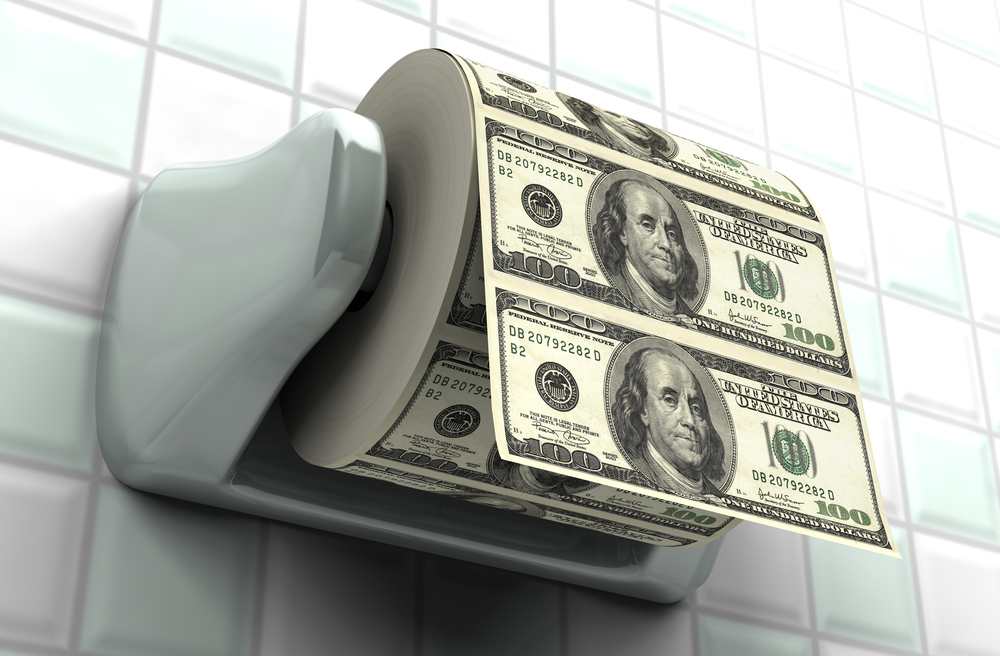‘What I’ve learned at the Federal Reserve is a new language which is called “Fed speak.” You soon learn to mumble with great incoherence.’
—Former Federal Reserve chairman Alan Greenspan
Alan Greenspan is alive and well. Aged 92, he was on TV yesterday telling viewers that ‘unless they get control of the debt,’ there will be hell to pay.
Greenspan is one of the most interesting characters in modern economics. And, unlike his successors, Bernanke and Yellen, he is not just an academic simpleton. He once had a very clear idea of how economies work. He saw the critical role of gold, for example, and warned that removing it from the US monetary system would lead to trouble.
Here he is in 1966:
‘This is the shabby secret of the welfare statists’ tirades against gold. Deficit spending is simply a scheme for the confiscation of wealth. Gold stands in the way of this insidious process. It stands as a protector of property rights. If one grasps this, one has no difficulty in understanding the statists’ antagonism toward the gold standard.’
We invited him to our office in Baltimore in late 2016. We wanted to see if he still had his head screwed on straight. But it was hard to know. Wiley and elusive, Mr Greenspan resisted direct questions.
Old fox
Back in the 1970s, Mr Greenspan’s career took an amazing turn. He must have seen that fame, fortune, and status rarely keep company with a clear-headed, honest economist.
A true economist is an observer of human folly with a sly grin on his face, an ironicist with an empty pocket. He is not a politician, a functionary, a world improver, a booster, a salesman, or a demand manager. And he’s certainly not a miracle worker.
Mr Greenspan wanted what a true economist couldn’t get — his face on the cover of TIME…and Andrea Mitchell. He knew he couldn’t get either by telling the truth. So he mumbled.
But the old fox wasn’t mumbling yesterday. He warned that we will see rising rates and rising unemployment. ‘Stagflation,’ in other words.
Here’s Greenspan on Bloomberg:
‘You’re getting into a system now that has no outcome that’s in equilibrium other than inflation and no productivity growth.’
Agence France-Presse has confirmation, at least of the ‘flation’ part:
‘US consumer inflation got a bump in October, as prices for gasoline and electricity shot up, rising along with the cost of shelter and medical care, the government reported Wednesday. The increase in overall consumer prices was the largest in nine months.’
Also in the news was this observation from The Washington Post, confirming the ‘stag’ part:
‘Rising prices have erased US workers’ meager wage gains, the latest sign strong economic growth has not translated into greater prosperity for the middle and working classes.
‘Cost of living was up 2.9 percent from July 2017 to July 2018, the Labor Department reported Friday, an inflation rate that outstripped a 2.7 percent increase in wages over the same period. The average US “real wage,” a federal measure of pay that takes inflation into account, fell to $10.76 an hour last month, 2 cents down from where it was a year ago.
‘The stagnation in pay defies US growth, which has increased in the past year and topped 4 percent in the second quarter of 2018 — the highest rate since mid-2014.’
Win-win world
You may recall that ‘stagflation’ was thought to be impossible. The Phillips Curve suggested that inflation drove employment. That’s why the feds pursue a 2% inflation target rather than a 0% inflation target.
They think the extra money adds to consumer demand…which then puts people to work producing things to sell.
All nonsense, of course. ‘Products are bought with products,’ not with money alone, said the great 19th-century French economist, Jean-Baptiste Say.
He was describing the real world…the win-win world. If you want something, you’ve got to give something in return. Which means you have to produce something to give — and not just a piece of paper with green ink on it.
This basic insight is at the heart of civilisation (trading, sharing, cooperating…rather than stealing). And it is at the heart of progress and prosperity, too (the more you want, the more new and better products you have to come up with).
But the real métier of most modern economists is not merely telling soothing and incoherent lies; it’s preventing people from seeing the truth.
Rose-coloured glasses are not enough. They go for the eyes…with sharp objects, absurd theories, and outrageous lies.
They tell people they can get richer by hocus pocus — increasing the money supply, lowering the interest rate, manipulating statistics, or stealing from future generations by racking up obscene levels of debt.
Fin de Bubble Age
Asked whether the tax cut might ignite enough extra growth to raise federal revenues and reduce deficits, Mr Greenspan was uncharacteristically direct:
‘No…there is no chance,’ we heard him say. ‘You get a little ‘bounce’ at the beginning, but that is just about over. After that, a tax cut makes no sense unless you are willing to ‘fund’ it…that is, to cut spending.’
‘You can’t get something for nothing,’ he might have said, providing a handy epithet for the whole Fin de Bubble Age.
An unfunded tax cut is just a hustle, shifting the burden of government boondoggles from the current taxpayers to the taxpayers of tomorrow. The money (the product!) has to come from somewhere.
Since our own outlook aligns nicely with that of the former Fed chief, aka Alan ‘Bubbles’ Greenspan, we presume we are both wrong. But you never know.
Regards,
Bill Bonner
